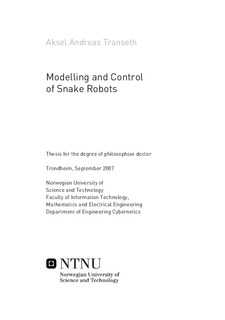| dc.description.abstract | Snake robots have the potential of contributing vastly in areas such as rescue missions, fire-fighting and maintenance where it may either be too narrow or too dangerous for personnel to operate. This thesis reports novel results within modelling and control of snake robots as steps toward developing snake robots capable of such operations.
A survey of the various mathematical models and motion patterns for snake robots found in the published literature is presented. Both purely kinematic models and models including dynamics are investigated. More-over, different approaches to both biologically inspired locomotion and artificially generated motion patterns for snake robots are discussed.
Snakes utilize irregularities in the terrain, such as rocks and vegetation, for faster and more efficient locomotion. This motivates the development of snake robots that actively use the terrain for locomotion, i.e. obstacle aided locomotion. In order to accurately model and understand this phenomenon, this thesis presents a novel non-smooth (hybrid) mathematical model for 2D snake robots, which allows the snake robot to push against external obstacles apart from a .at ground. Subsequently, the 2D model is extended to a non-smooth 3D model. The 2D model offers an efficient platform for testing and development of planar snake robot motion patterns with obstacles, while the 3D model can be used to develop motion patterns where it is necessary to lift parts of the snake robot during locomotion. The framework of non-smooth dynamics and convex analysis is employed to be able to systematically and accurately incorporate both unilateral contact forces (from the obstacles and the ground) and spatial friction forces based on Coulomb’s law using set-valued force laws. Snake robots can easily be constructed for forward motion on a flat surface by adding passive caster wheels on the underside of the snake robot body. However, the advantage of adding wheels suffers in rougher terrains. Therefore, the models in this thesis are developed for wheel-less snake robots to aid future development of motion patterns that do not rely on passive wheels.
For numerical integration of the developed models, conventional numerical solvers can not be employed directly due to the set-valued force laws and possible instantaneous velocity changes. Therefore, we show how to implement the models for simulation with a numerical integrator called the time-stepping method. This method helps to avoid explicit changes between equations during simulation even though the system is hybrid. Both the 2D and the 3D mathematical models are verified through experiments. In particular, a back-to-back comparison between numerical simulations and experimental results is presented. The results compare very well for obstacle aided locomotion.
The problem of model-based control of the joints of a planar snake robot without wheels is also investigated. Delicate operations such as inspection and maintenance in industrial environments or performing search and rescue operations require precise control of snake robot joints. To this end, we present a controller that asymptotically stabilizes the joints of a snake robot to a desired reference trajectory. The 2D and 3D model referred to above are ideal for simulation of various snake robot motion pattern. How-ever, it is also advantageous to model the snake robot based the standard equations of motion for the dynamics of robot manipulators. This latter modelling approach is not as suited for simulation of a snake robot due to its substantial number of degrees of freedom, but a large number of control techniques are developed within this framework and these can now be employed for a snake robot. We first develop a process plant model from the standard dynamics of a robot manipulator. Then we derive a control plant model from the process plant model and develop a controller based on input-output linearization of the control plant model. The control plant model renders the controller independent of the global orientation of the snake robot as this is advantageous for the stability analysis. Asymptotic stability of the desired trajectory of the closed-loop system is shown using a formal Lyapunov-based proof. Performance of the controller is, first, tested through simulations with a smooth dynamical model and, second, with a non-smooth snake robot model with set-valued Coulomb friction.
The three main models developed in this thesis all serve important purposes. First, the 2D model is for investigating planar motion patterns by effective simulations. Second, the 3D model is for developing motion patterns that require two degrees of freedom rotational joints on the snake robot. Finally, the control plant model is employed to investigate stability and to construct a model-based controller for a planar snake robot so that its joints are accurately controlled to a desired trajectory. | nb_NO |
